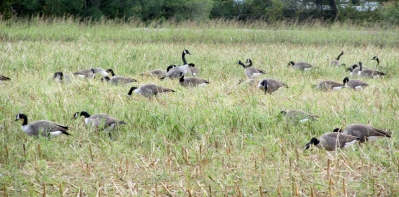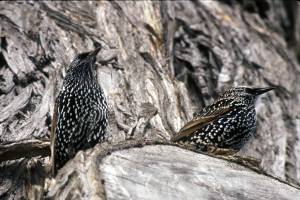
Photo by Bryan Stevens A flock of Canada Geese in a field near the Watauga River in Elizabethton on the day of the Fall Bird Count.
The 46th annual Elizabethton Fall Count was held on Saturday, Sept. 26.
A total of 37 observers in nine parties covered Carter County and parts of adjacent Johnson, Sullivan, Unicoi and Washington counties in this yearly count conducted by the Lee and Lois Herndon Chapter of Tennessee Ornithological Society, or the Elizabethton Bird Club. This year’s count included new territory around Kingsport that has not traditionally been a part of this annual fall survey.
A total of 129 species were found, which is slightly above the average of 125 over the last 30 years. The all-time high of 137 species was achieved in 1993.
The most numerous bird on the count was the European Starling (1,347) followed closely by Canada Goose (1,182) and American Crow (896).

Photo by Bryan Stevens Mourning Doves were one of the more abundant birds on this year’s Fall Bird Count.
Other numerous birds included Mourning Dove (529), Chimney Swift (490), Blue Jay (432) and Rock Pigeon (375).
Of course, some birds were represented by only one individual, such as Northern Harrier, Great Egret, American Wigeon, Ruffed Grouse, Peregrine Falcon, Olive-sided Flycatcher, Eastern Kingbird, Worm-eating Warbler, Northern Waterthrush, Nashville Warbler and Yellow-breasted Chat.
The total follows:
Canada Goose, 1,182; Wood Duck, 90; American Wigeon, 1; Mallard, 254; Blue-winged Teal, 13; Ruffed Grouse, 1; Wild Turkey, 161; Pied-billed Grebe, 9; and Double-crested Cormorant, 31.
Great Blue Heron, 39; Great Egret, 1; Green Heron, 7; Black-crowned Night-heron, 4; Black Vulture, 172; and Turkey Vulture, 189.
Osprey, 19; Northern Harrier, 1; Sharp-shinned Hawk, 5; Cooper’s Hawk, 10; Bald Eagle, 8; Red-shouldered Hawk, 3; and Red-tailed Hawk, 16.
Sora, 4; American Coot, 2; Killdeer, 87; Spotted Sandpiper, 3; Solitary Sandpiper, 5; Willet, 1; Sanderling, 2; Least Sandpiper, 1; and American Woodcock, 1.
Ring-billed Gull, 4; Forster’s Tern, 1; Rock Pigeon, 375; Eurasian Collared-Dove, 5; Mourning Dove, 529; and Black-billed Cuckoo, 1.
Eastern Screech-owl, 27; Great Horned Owl, 3; Barred Owl, 1; Northern Saw-whet Owl, 1; Chimney Swift, 490; Ruby-throated Hummingbird, 36; and Belted Kingfisher, 33.
Red-headed Woodpecker, 1; Red-bellied Woodpecker, 73; Yellow-bellied Sapsucker, 1; Downy Woodpecker, 53; Hairy Woodpecker, 7; Northern Flicker, 54; and Pileated Woodpecker, 28.

Photo by U.S. Fish & Wildlife Service
The European Starling ranked as the most common species on the count.
American Kestrel, 24; Merlin, 2; Peregrine Falcon, 1; Olive-sided Flycatcher, 1; Eastern Wood-Pewee, 14; Acadian Flycatcher, 2; Eastern Phoebe, 71; and Eastern Kingbird, 1.
White-eyed Vireo, 3; Yellow-throated Vireo, 1; Blue-headed Vireo, 6; Red-eyed Vireo, 4; Blue Jay, 432; American Crow, 896; and Common Raven, 8.
Northern Rough-winged Swallow, 1; Tree Swallow, 231; Cliff Swallow, 2; Carolina Chickadee, 128; Tufted Titmouse, 111; Red-breasted Nuthatch, 1; and White-breasted Nuthatch, 43.
House Wren, 6; Marsh Wren, 1; Carolina Wren, 152; Blue-gray Gnatcatcher, 2; Golden-crowned Kinglet, 2; and Ruby-crowned Kinglet, 2.

Photo by Bryan Stevens A total of 21 species of warblers, such as this Northern Waterthrush, were counted during the Fall Bird Count.
Eastern Bluebird, 230; Veery, 1; Gray-cheeked Thrush, 1; Swainson’s Thrush, 23; Wood Thrush, 12; American Robin, 312; Gray Catbird, 60; Brown Thrasher, 19; Northern Mockingbird, 76; European Starling, 1,347; and Cedar Waxwing, 132.
Ovenbird, 2; Worm-eating Warbler, 1; Northern Waterthrush, 1; Black-and-white Warbler, 6; Tennessee Warbler, 12; Nashville Warbler, 1; Common Yellowthroat, 25; Hooded Warbler, 4; American Redstart, 51; Cape May Warbler, 8; Northern Parula, 2; Magnolia Warbler, 24; Bay-breasted Warbler, 8; Blackburnian Warbler, 7; Chestnut-sided Warbler, 7; Black-throated Blue Warbler, 2; Palm Warbler, 54; Pine Warbler, 2; Yellow-throated Warbler, 1; Black-throated Green Warbler, 4; and Yellow-breasted Chat, 1.

Photo by Bryan Stevens Scarlet Tanagers were still present in good numbers for the Fall Bird Count on Sept. 26.
Eastern Towhee, 59; Chipping Sparrow, 37; Field Sparrow, 14; Song Sparrow, 99; Dark-eyed Junco, 31; Scarlet Tanager, 16; Northern Cardinal, 188; Rose-breasted Grosbeak, 28; Blue Grosbeak, 1; and Indigo Bunting.
Red-winged Blackbird, 60; Eastern Meadowlark, 41; Common Grackle, 67; Brown-headed Cowbird, 15; Baltimore Oriole, 3; House Finch, 55; American Goldfinch, 188; and House Sparrow, 56.


